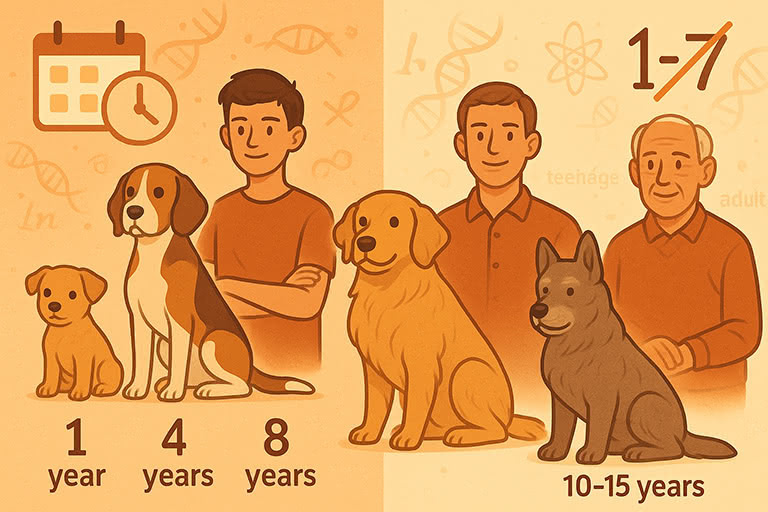🐕 Dog Years to Human Years: The Definitive Guide

🎯 Why People Convert Dog Years to Human Years
The idea of “dog years” comes from our desire to relate a dog’s life stages to human life stages. This helps us:
- Understand their development (puppyhood, adolescence, maturity, senior years)
- Make sense of their lifespan
- Anticipate health needs
The simplistic rule that 1 dog year = 7 human years is not accurate. Dogs mature much faster early in life, and breed/size have a big impact on aging rates.
⏳ The Problem with the “1:7” Rule
This rule likely originated as a rough average: if the average dog lived ~10–12 years, and humans lived ~70–80, that’s ~1:7.
However:
- A 1-year-old dog is not the equivalent of a 7-year-old child—it’s more like a teenager.
- Dogs of different breeds and sizes age at different rates.
- Aging is non-linear: early years progress faster in maturity.
🧬 A More Accurate Model: The Nonlinear Approach
In 2019, researchers at the University of California San Diego (UCSD) published a DNA methylation study (“epigenetic clock”) comparing dog and human aging.
They proposed this formula (for Labrador Retrievers): Human Age = 16 × ln(Dog Age) + 31
Where:
- ln is the natural logarithm.
- This formula shows how dogs mature very rapidly at first, then more slowly.
Examples:
| Dog Age (years) | Human Equivalent (years) |
|---|---|
| 1 | ~31 |
| 2 | ~42 |
| 5 | ~56 |
| 10 | ~67 |
| 15 | ~74 |
Note: This was based on Labrador Retrievers; other breeds will differ.
🐶 Breed Size and Lifespan
Smaller breeds (e.g., Chihuahuas) tend to live longer, and their aging slows sooner. Large and giant breeds (e.g., Great Danes) age faster overall.
General trends:
- First 1–2 years: Dogs mature rapidly (reach sexual maturity).
- Small dogs: Slower aging after ~2 years, longer lifespan.
- Large dogs: Faster aging after ~2 years, shorter lifespan.
📊 Breed-Size Age Chart (Approximate)
| Dog Age (Years) | Small (<20 lbs) | Medium (20–50 lbs) | Large (>50 lbs) |
|---|---|---|---|
| 1 | 15 human years | 15 human years | 14 human years |
| 2 | 24 | 24 | 22 |
| 3 | 28 | 28 | 31 |
| 4 | 32 | 32 | 38 |
| 5 | 36 | 36 | 45 |
| 6 | 40 | 42 | 50 |
| 7 | 44 | 47 | 56 |
| 8 | 48 | 51 | 64 |
| 9 | 52 | 56 | 71 |
| 10 | 56 | 60 | 78 |
| 11 | 60 | 65 | 86 |
| 12 | 64 | 69 | 93 |
| 13 | 68 | 74 | 101 |
| 14 | 72 | 78 | 108 |
| 15 | 76 | 83 | 115 |
🧠 Key Points to Remember
✅ Dogs don’t age linearly.
✅ Breed and size have major impact.
✅ First year ≈ teenage human years.
✅ Epigenetic data gives a more scientific view, but still varies by breed.
✅ Regular veterinary care is the best way to monitor your dog’s true age-related health.
🛠️ How to Calculate More Precisely
To estimate your dog’s age in human years:
- Determine breed size category.
- Use the chart above for reference.
- For Labradors (or similar breeds), you can also use:
You might also like
Cat Years to Human Years: The Ultimate Guide to Your Feline's Age
Curious about your cat's age? Our guide breaks down cat years to human years, explaining the science behind the calculation and what each life stage means for your pet.
🐾 Weird Wheels: The Curious Case of Animal Speed
From sprinting lizards to slothful salamanders, discover the surprising speeds of some of the world’s weirdest animals.